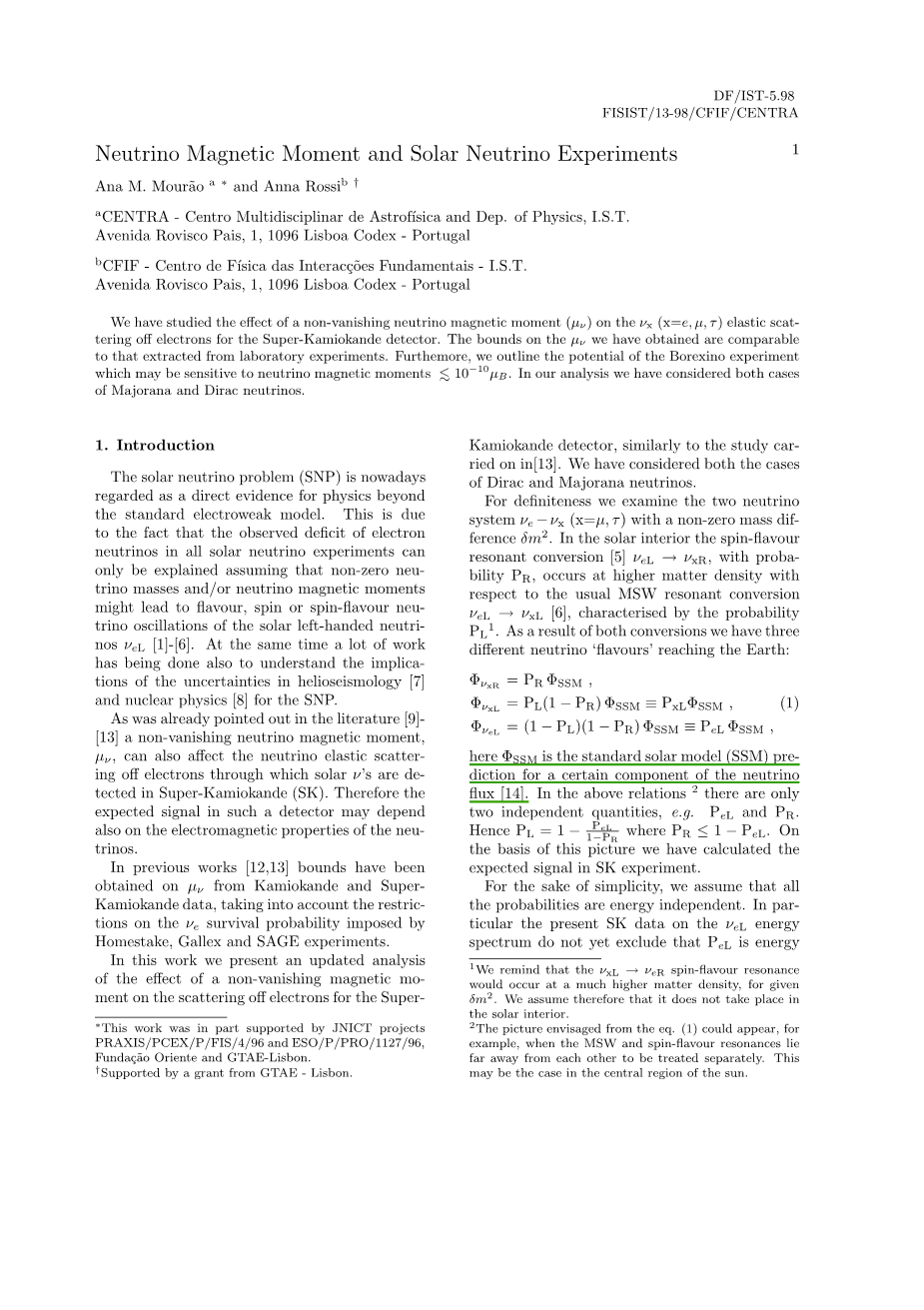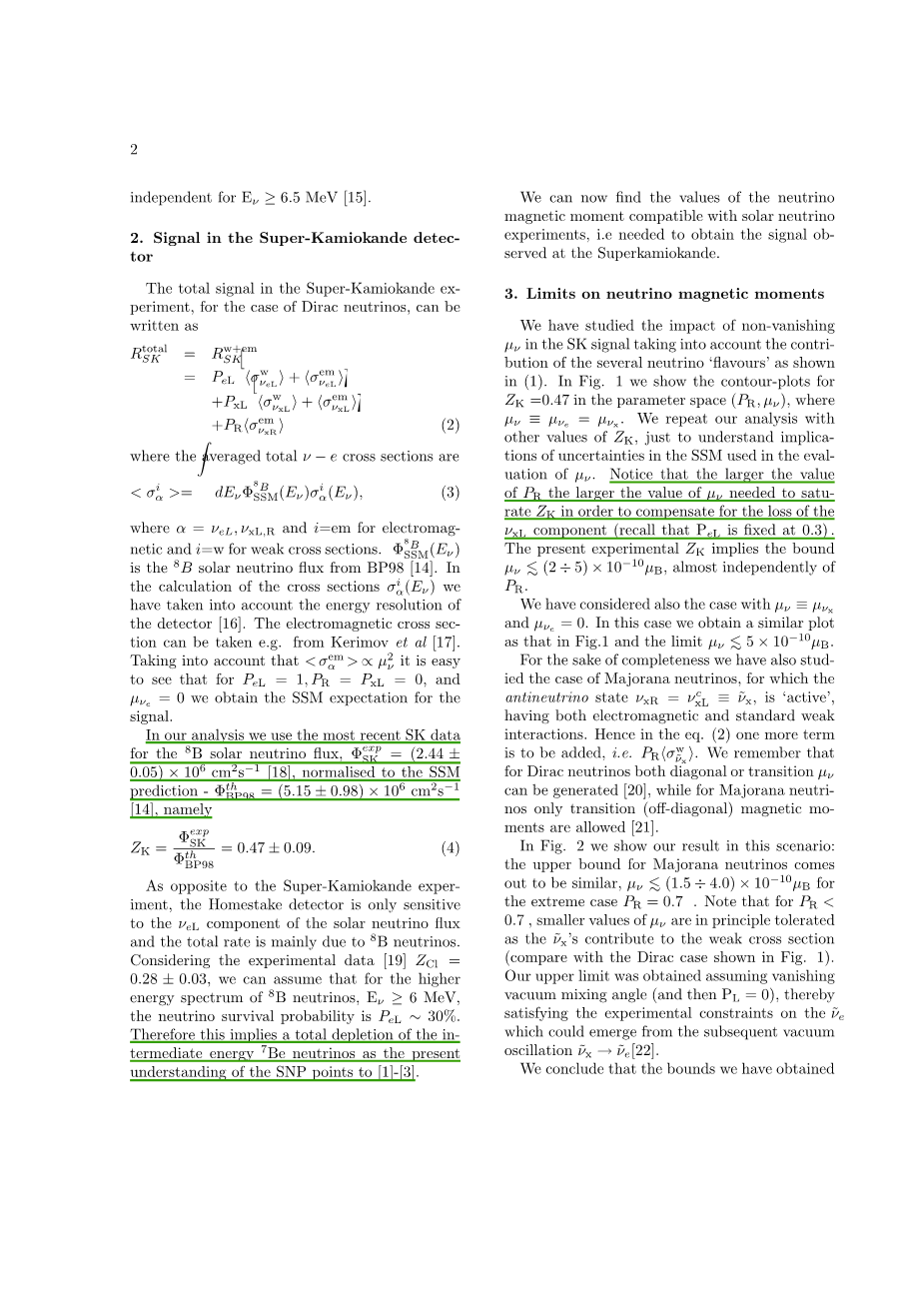外文翻译资料
2022-12-29 11:46:23
本科毕业设计(论文)
外文翻译
Neutrino Magnetic Moment and Solar Neutrino Experiments
作者:Ana M. Mouro and Anna Rossi
国籍:Portugal
出处:Ana M. Mouro and Anna Rossi,Neutrino Magnetic Moment and Solar Neutrino Experiments [J], Nuclear Physics B(Proc.Suppl.)77(1999)89-92
原文正文:
We have studied the effect of a non-vanishing neutrino magnetic moment () on the ( elastic scattering off electrons for the Super-Kamiokande detector. The bounds on the we have obtained are comparable to that extracted from laboratory experiments. Furthermore, we outline the potential of the Borexino experiment which may be sensitive to neutrino magnetic moments In our analysis we have considered both cases of Majorana and Dirac neutrinos.
1. Introduction
The solar neutrino problem (SNP) is nowadays regarded as a direct evidence for physics beyond the standard electroweak model. This is due to the fact that the observed deficit of electron neutrinos in all solar neutrino experiments can only be explained assuming that non-zero neutrino masses and/or neutrino magnetic moments might lead to flavour, spin or spin-flavour neutrino oscillations of the solar left-handed neutrinos [1]-[6]. At the same time a lot of work has being done also to understand the implications of the uncertainties in helioseismology [7] and nuclear physics [8] for the SNP.
As was already pointed out in the literature [9]-[13] a non-vanishing neutrino magnetic moment, , can also affect the neutrino elastic scattering off electrons through which solar nu;rsquo;s are detected in Super-Kamiokande (SK). Therefore the expected signal in such a detector may depend also on the electromagnetic properties of the neutrinos.
In previous works [12,13] bounds have been obtained on from Kamiokande and Super-Kamiokande data, taking into account the restrictions on the survival probability imposed by Homestake, Gallex and SAGE experiments.
In this work we present an updated analysis of the effect of a non-vanishing magnetic moment on the scattering off electrons for the Super-Kamiokande detector, similarly to the study carried on in[13]. We have considered both the cases of Dirac and Majorana neutrinos.
For definiteness we examine the two neutrino system ( with a non-zero mass difference . In the solar interior the spin-flavour resonant conversion[5] →, with probability , occurs at higher matter density with respect to the usual MSW resonant conversion →[6], characterised by the probability . As a result of both conversions we have three different neutrino lsquo;flavoursrsquo; reaching the Earth:
,
, (1)
,
here is the standard solar model (SSM) prediction for a certain component of the neutrino flux [14]. In the above relations[1] there are only two independent quantities, e.g. and . Hence where 1. On the basis of this picture we have calculated the expected signal in SK experiment.
For the sake of simplicity, we assume that all the probabilities are energy independent. In particular the present SK data on the energy spectrum do not yet exclude that is energy independent for [15].
2. Signal in the Super-Kamiokande detector
The total signal in the Super-Kamiokande experiment, for the case of Dirac neutrinos, can be written as
, (2)
where the averaged total cross sections are
, (3)
where and i=em for electromagnetic and i=w for weak cross sections. is the 8B solar neutrino flux from BP98 [14]. In the calculation of the cross sections we have taken into account the energy resolution of the detector [16]. The electromagnetic cross section can be taken e.g. from Kerimov et al [17]. Taking into account that it is easy to see that for we obtain the SSM expectation for the signal.
In our analysis we use the most recent SK data for the 8B solar neutrino flux, [18], normalised to the SSM prediction - [14], namely
(4)
As opposite to the Super-Kamiokande experiment, the Homestake detector is only sensitive to the component of the solar neutrino flux and the total rate is mainly due to 8B neutrinos. Considering the experimental data [19] , we can assume that for the higher energy spectrum of 8B neutrinos, , the neutrino survival probability is . Therefore this implies a total depletion of the intermediate energy 7Be neutrinos as the present understanding of the SNP points to [1]-[3].
We can now find the values of the neutrino magnetic moment compatible with solar neutrino experiments, i.e needed to obtain the signal observed at the Superkamiokande.
3. Limits on neutrino magnetic moments
We have studied the impact of non-vanishing in the SK signal taking into account the contribution of the several neutrino lsquo;flavoursrsquo; as shown in (1). In Fig. 1 we show the contour-plots for ZK=0.47 in the parameter space (), where . We repeat our analysis with other values of ZK, just to understand implications of uncertainties in the SSM used in the evaluation of . Notice that the larger the value of the larger the value of needed to saturate ZK in order to compensate for the loss of the component (recall that is fixed at 0.3). The present experimental ZK implies the boun
剩余内容已隐藏,支付完成后下载完整资料


英语原文共 4 页,剩余内容已隐藏,支付完成后下载完整资料
资料编号:[276513],资料为PDF文档或Word文档,PDF文档可免费转换为Word




